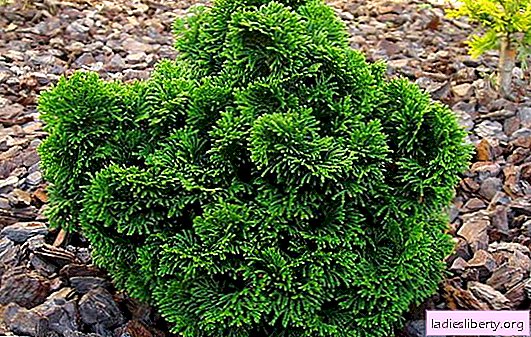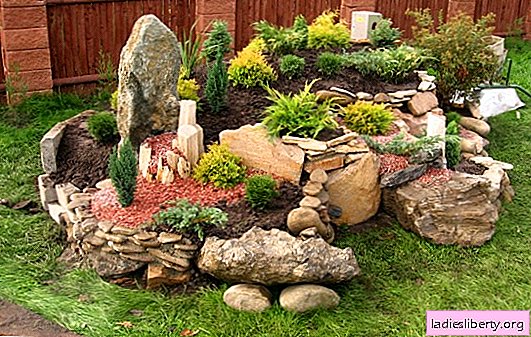
Cypress small conifer brought to us from North America and East Asia.
This coniferous plant reaches a height no more than a measure, is grown by gardeners, both at home and in the summer cottage.
Wonderful cypress fits into the landscape of any site or flowerbed.
In the midland, the cypress feels great, normally tolerates winter when planted in open ground.
To figure out how to properly conduct a cypress landing.
Leaving a photo will help determine when and how to prune and treat a coniferous plant.
Cypress: planting, variety selection
The main are 7 varieties, and several hundreds of species of breeding breeding.
1. Cypress is dumb.
2. Nutkansky.
3. Pea-bearing.
4. Yellow.
5. Tuevidny.
6. Cypress Lavson.
7. Formozsky.
North American and Japanese cypress species are better suited to our climate zone. Unlike ordinary cypress trees, they have good frost resistance. But in the summer, they require additional watering, the heat is very poorly tolerated. Therefore, it is necessary to choose varieties for planting in open ground frost-resistant. But for planting in a pot and when growing on a windowsill, you should choose a variety that does not need to have a large daylight. In winter, in the middle lane, daylight hours are short, so when choosing a variety that loves partial shade.
Cypress loves partial shade, but if the color is yellow, plant it on the sunny side.
Cypress loves an open place, light partial shade. The decorative leaves of the cypress are well-suited for moderate light, the lowlands are not a suitable place for planting the cypress, warm air reaches these places last, and in spring the roots will rot due to stagnation of melt water.
The cypress is planted in a permanent place in the spring, in April and early May, when the weather is warm without frost.
The landing site must be chosen well in advance, preferably in the fall. It is prepared, fertilized. They dig a hole of 50-80 cm in November and October. A nutrient substrate is added to the dug hole, taken for preparation:
• peat 2 parts;
• humus 2 parts;
• sand 1 part;
• turf land 3 parts.
During the end of autumn and winter, the prepared substrate rots out, warms up faster in spring (the better the loose soil, the faster it warms up in spring).
Mandatory drainage, the plant in stagnant water will quickly die (rot the root system). Drainage is made at the bottom of the prepared pit, pouring broken pieces of brick or large gravel.
Clay soil for planting is not suitable, the ground should be crumbly, moderately moist.
Additionally, fertilizers are applied during planting, interfering with part of the earthen substrate. The landing pit should be wide, the root system should be branched and not very deep.
Reproduction of cypress, planting and care with a photo
Cypress propagates:
• cuttings;
• seeds;
• bends.

Propagation by cuttings

It is possible to grow a cypress from seeds, but breeders are engaged in this method of reproduction. Seed collection is carried out in dry weather in the fall, dried and poured into a container with a tight lid. Store at a temperature of at least 5 degrees.
With proper collection and storage of seeds, germination is preserved and they can be stored from 8 to 17 years.

Seed cultivation
When planting, the lump with the root system is treated with the Kornevina special agent.
They also dilute the product for half a bucket of water and water the planted plant in the ground. This will allow better rooting and eliminate rotting of the horse system.
Cypress: care
Cypress capricious look, requires mandatory top dressing. This coniferous plant is quite capricious in care, although it is found in the wild and grows and multiplies well there. In the summer, the required full-fledged irrigation and top dressing with mineral fertilizers.
In spring, complex fertilizer is applied to the soil. If the plant is grown in open ground, then watering should be at least 10 liters at a time. Dry climate requires increased watering. But the plant does not like to fill in and overly watering, the root system will suffer from this.
Excellent cypress responds to spraying, once a week carry out such procedures. For a houseplant in a dry climate, in hot summers, spend every three days. The soil around the plant is mulched; peat mixed with sliver is used for this. When mulching, watering is done somewhat less frequently, focusing on the drying of the mulch.

Cypress - decorative trim
Plant care also includes pruning dry foliage from the plant. In the spring, they begin leaving by trimming old and dry branches of the plant, and also remove the ends of the frozen leaves. The crown of the cypress is also formed in the spring. For one haircut, no more than a third of the green mass is cut.
More often, the plant is sheared with the support of a natural conical or pyramidal shape.
In the fall, at the end of the growing season, so that the crown becomes more magnificent and thicker, a third of the growth of the current year is removed, keeping the plant in shape. Bare branches can not be left, they will dry out.
To form a crown begin a year after planting or transplanting a plant to a new place.
Such decorative pruning will look at home and also at garden views. Such pruning is carried out on already grown plants, too young cypress should not be pruned.
Cypress: top dressing
After transplanting a young plant, the first dressing should be carried out no earlier than two weeks later. The concentration of the solution is half as much as for irrigation of an adult species.
Adult cypresses are fed with complex fertilizers with minerals, such mineral watering is carried out twice a month. Feeding begins to be carried out from spring to mid-July; from mid-summer, feeding is stopped. Termination of nutrition is necessary otherwise the plant does not have time to prepare for winter.
The necessary mineral dressing can be purchased at any specialized store.
Cypress: pests and diseases
Cypress coniferous plant, which is not often susceptible to diseases and pests.
Often hit:
• shield;
• Putin tick.
To detect damage by a spider mite, you can pay attention to the yellowed crown and falling leaves. If the plant is indoor and small from the spider mite, a soap solution helps. They should be washed several times a week, if the mite defeat has captured most of it, spray it with Nuprid. If an adult plant should be treated with acaricides.
The scabbard eats the juice of the plant, from this the leaves dry and fall off. Processing "Nuprid" will have several times.

Cypress spider mite
One of the common diseases of this eternal green plant is root rot. A fungal disease occurs with improper care of the plant, a common cause is stagnation of moisture in the roots, excessive watering.
If the root system is completely damaged by rot, then the plant is destroyed. When the disease is noticed in time, the cypress is dug up, the affected roots are cut off and treated with a fungicide. The wounds should dry out a little (enough hours), after treatment they can be additionally sprinkled with charcoal, transplanted to another place with prepared soil and a good drainage system.

Root decay











